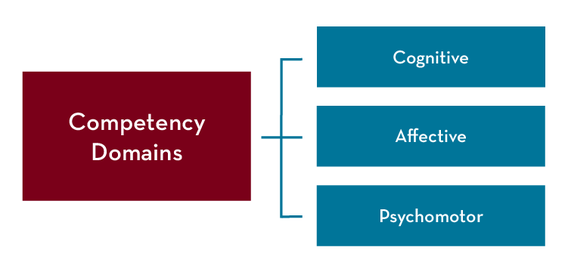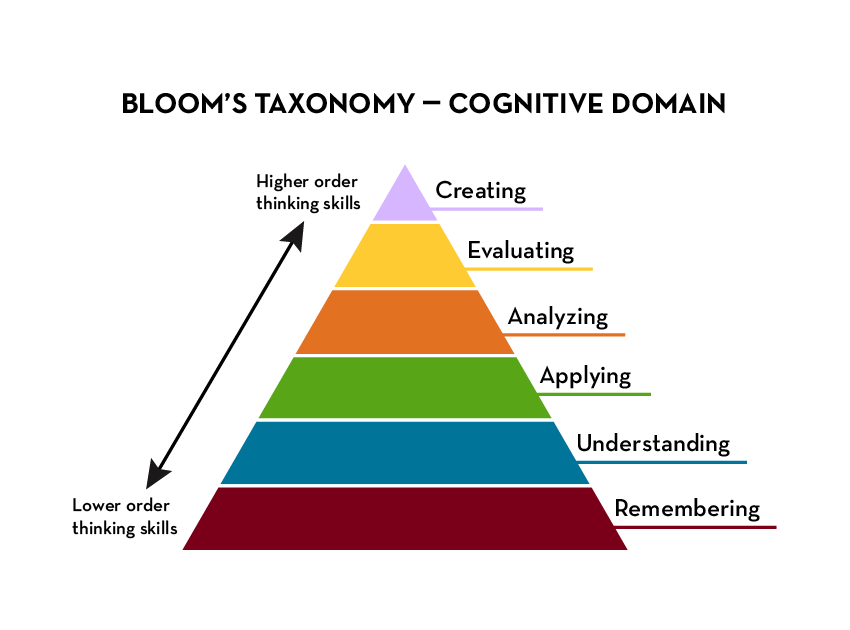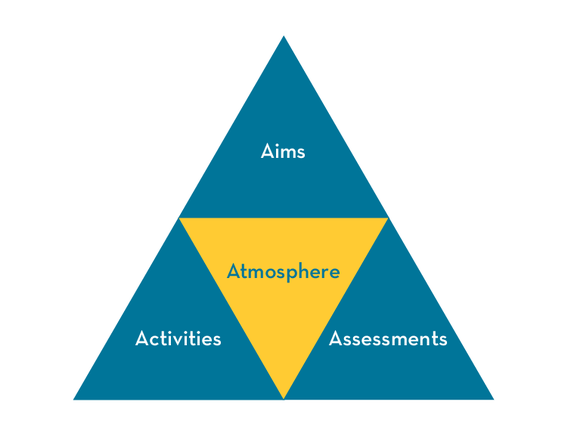"Based on your learning objectives for the class or the session, consider what performance and products would provide you with acceptable evidence that your students are able to meet your learning objectives."
- McTighe, 2019
The assessment you choose will depend on the type and level of your learning aims. There are multiple domains that can be assessed including cognitive, affective, and psychomotor.

Resource document: Bloom’s Cognitive, Affective, and Psychomotor Domains suggested verbs and examples.
Within the cognitive domain, Bloom’s taxonomy is often used to categorize the levels of competencies (knowledge and skills) we want our students to acquire. These are used to shape course and session learning aims which provide the basis for designing assessments.

For any given aim, there may be multiple effective forms of evidence students can provide to demonstrate their understanding.
Examples:
- In a history class with a learning aim of Describe the major factors that contributed to the Great Migration, acceptable evidence of this might be for students to:
- Predict how the Great Migration may have been impacted had civil rights legislation been passed in 1920 rather than 1964?
- Provide evidence from U.S. census data to support one of the contributing factors discussed in class.
- In a physiology class with a learning aim of Describe the steps involved in regulating clotting of the blood, acceptable evidence of this ability might be for students to:
- Draw a diagram of the process and indicate which steps are affected and in what way in the presence of an anticoagulant drug.
- List and describe two disorders associated with mutations in the genes for any of the proteins involved in the process.
The table below includes examples of assessments that are designed to support learning aims for different disciplines. Adapted from Indiana University Center for Innovative Teaching and Learning.
| Discipline | Leaning aim(s) | Assessment |
|---|---|---|
| Nursing |
|
Based on a case study of an elderly patient, assess and create a plan of care. |
| Business |
|
Develop a sales plan for an imaginary (or real) company. |
| Computer Science |
|
Develop an app to solve a particular problem and/or meet a set of criteria. |
| Psychology |
|
Examine/critique a case study from a patient with a mood disorder from two different theoretical positions. |
| Public Affairs or Service Learning |
|
Predict how a community agency budget may be impacted by COVID-19. |
| Biology |
|
Draw a diagram of the factors that regulate blood clotting and indicate what happens in the presence of an anti-coagulant drug. |
| History |
|
Describe what might have happened if a specific element of an historical event had changed. |
For a particular form of evidence there are multiple assessment types from which to choose.
For example: If you would like students to demonstrate that they can predict how the Great Migration may have been impacted had civil rights legislation been passed in 1920, students could be asked to:
- answer a question on an essay exam.
- write a paper citing primary literature.
- answer a multiple-choice question.
Read more about selecting the appropriate assessment for your course.
Ultimately, your assessments drive the choice of learning activities and teaching strategies to use. The aims, assessments, and activities should be in alignment.

Ask yourself: Am I assessing the most important aspects of my learning aim(s)?
For example: If your course aims are for students to be able to compare and contrast different psychological theories of mood disorders, assessments that merely ask students to define and identify different psychological theories would not tell you if students could compare and contrast them. An assessment that asks students to critique a case study from a patient with a mood disorder from two different theoretical positions would align with this learning aim.
Ask yourself: Am I assessing material that I emphasized as important in class or the reading?
Furthermore, in this example: if your assessment did align with your learning aim but your course activities only focused on lecturing to students about the different theories and definitions of mood disorders with no application to real-world case studies, students would be unlikely to perform well on the assessment. You may be disappointed in student performance, and may receive complaints from students that the assessment was “unfair” because it was not what you focused on in class.
Document resource: Template to use for aligning Aims, Assessments, and Activities.